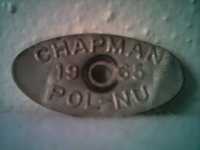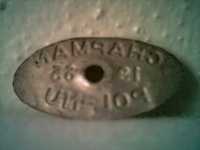

Insulators Home > My Collection > Miscellaneous > Pole Treatment Tags


Material: Metal (aluminum)
Year: 1965
Size: 0.75 inch height; 1.5 inch width
Usage: nailed to wood poles to indicate preservation treatment used
This means Chapman Chemical Company's 'Pol-Nu' was used on this pole. Pol-Nu's primary ingredient is pentachlorophenol, or 'penta'. The National Safety Council's Chemical Library describes its characteristics. The CDC NIOSH, NIH NIEHS, and Scorecard Chemical Profile indicate this chemical is carcinogenic. The Canadian Institute of Treated Wood says linemen's exposure risks are normally low.
Penta serves the same purpose as creosote -- prolonged preservation of the wood's integrity. According to Conrad Forest Products (and Paint & Coatings Industry Magazine), creosote was invented in 1875, and pentachlorophenol was invented around 1920-1930.
The Pole Maintenance Company's (PMC) site includes a US Dept. of Agriculture report of a test performed from 1957 to 1978 in Mississippi using Southern Pine poles, the results of which showed Pol-Nu to be far more effective at preserving the poles' stability longer than the other substances tested. PMC also describes penta's effectiveness as a supplemental treatment for creosote-treated poles after about 18 years, and application methods. The NCAMP quotes the American Wood Preservers Institute, saying treatment of poles in 1995 was 45% with penta, 42% with CCA (chromated copper arsenate), and 13% with creosote.
Marking: (Arc) CHAPMAN / 1965 / (Arc) POL-NU
Acquired: August 12, 2004 - gift from Chris S.
Notes: retrieved from a pole in Woodville, TX
Insulators Home > My Collection > Miscellaneous > Pole Treatment Tags
Contact: A.C. Walker